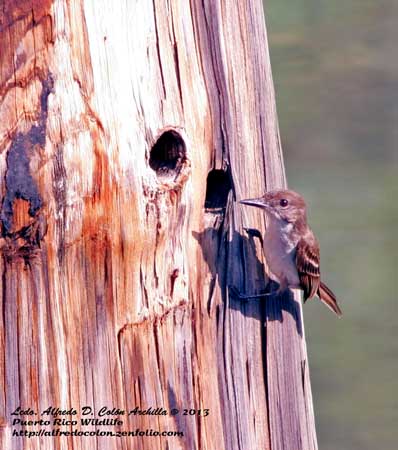
Fr: Tyran de Porto Rico
All: Puerto-Rico-Schopftyrann
Esp: Copetón Puertorriqueño
Puerto Rico: Juí
Ita: Pigliamosche di Portorico
Nd: Puerto-Ricotiran
Sd: Puerto Ricotopptyrann
Photographer:
Alfredo Colón
Puerto Rico Wildlife
Text by Nicole Bouglouan
Sources:
HANDBOOK OF THE BIRDS OF THE WORLD Vol 9 - by Josep del Hoyo - Andrew Elliot - David Christie - Lynx Edicions - ISBN: 8487334695
BirdLife International (BirdLife International)
Aves de Porto Rico – Sociedad Ornitológica Puertorriqueña
Neotropical Birds – Cornell Lab of Ornithology
Puerto Rican Flycatcher
Myiarchus antillarum
Passeriformes Order – Tyrannidae Family
INTRODUCTION:
The Puerto Rican Flycatcher of genus Myiarchus belongs to the tribe Attilini in the Tyrannidae family. This genus includes the most widespread of all flycatchers, and they have larger size. Their peculiar nesting behaviour, with the nest built inside cavities, make them different from other genera. This species is endemic to the archipelago of Puerto Rico.
Its local name, Juí, comes from its plaintive whistle.

DESCRIPTION OF THE BIRD:
Length: 18-20 cm
Weight: 22-25 g
The adult has brown back, mantle and scapulars. The uppertail-coverts are more rufescent. On the upperwing, primaries show rufous outer edges, whereas secondaries and tertials have pale greyish ones. Greater and median wing-coverts are conspicuously tipped greyish-white. The tail is brown. The outer rectrices show paler outer webs and there is sometimes some rufous colour on tips of inner webs of most rectrices.
On the underparts, throat and breast are pale greyish with indistinct paler streaks. Belly and undertail-coverts are pale yellowish-white. We can see a brownish wash on lower breast sides. Underwing-coverts are pale yellowish.
On the head, the crown is olive-brown. Chin and cheeks are pale greyish. Lores are darker grey.
The bill is blackish. The eyes are dark brown. Legs and feet are black.
Both sexes are similar.
The juvenile shows rufous-tipped wing-coverts.

RANGE:
The Puerto Rican Flycatcher is found on Puerto Rico, Vieques, Culebra and Virgin Islands.
HABITAT:
The Puerto Rican Flycatcher frequents various types of wooded areas and can be found in tropical deciduous forest, wetland forest, mangroves and borders, arid scrub, citrus groves and coffee plantations. This species occurs from sea-level up to 800 metres of elevation.

CALLS AND SONGS: SOUNDS BY XENO-CANTO
The Puerto Rican Flycatcher utters a plaintive whistle “whee” (or “juí” in Spanish). This sound is frequently heard all the day during the breeding season.
The typical Tyrannidae dawn song is a combination of “huit” notes and rolling “brrr-r-r”, with a dissyllabic “wick-up” as middle element. The dawn song is given from a perch. The bird remains motionless during several minutes and sings just at the very first light of the day.

BEHAVIOUR IN THE WILD:
The Puerto Rican Flycatcher feeds mainly on several insect species such as hemipterans, orthopterans, coleopterans, hymenopterans and caterpillars. It also takes Anolis lizards, snails and tree frogs, and consumes seeds and berries (16% of the diet). Insects are sometimes caught on the wing, but the bird is inconspicuous and usually heard but rarely seen. It perches among the canopy foliage from which it sallies for preys. Hovering, gleaning and aerial sally-hovering are the usual foraging techniques. It forages in the canopy foliage, but also on branches and tree trunks.

During the breeding season, display behaviour between male and female and aggressive encounters between rivals are reported.
Usually, the Myiarchus species are monogamous, and the pair defends its territory. As non-migrant species, it remains in its territory, sometimes in small family groups.
The courtship displays are poorly known, but this species is a cavity nester.
The Puerto Rican Flycatcher is sedentary in its range. It performs hovering and short flights while foraging, but it does not perform long, sustained flights.

REPRODUCTION OF THIS SPECIES:
The breeding season occurs between February and June. The Puerto Rican Flycatcher starts to inspect holes and various cavities in April-May. It may use artificial nest boxes too.
The nest is built inside a cavity. It is made with plant stems and lined with softer materials such as rootlets, feathers and horse hair.

The female lays 3-5 yellowish eggs with brown spots. Both adults have an incubating patch and share the incubation. The young birds fledge about two weeks after hatching.
The nest is often parasitized by the Shiny Cowbird.

PROTECTION / THREATS / STATUS:
The Puerto Rican Flycatcher has restricted range where it is common to fairly common. It is threatened by habitat loss due to natural causes such as hurricanes, but also to human causes such as vegetation clearance. Brood parasitism also plays a role in declines.
The species is decreasing due to these threats, but currently, the Puerto Rican Flycatcher is still listed as not globally threatened.

